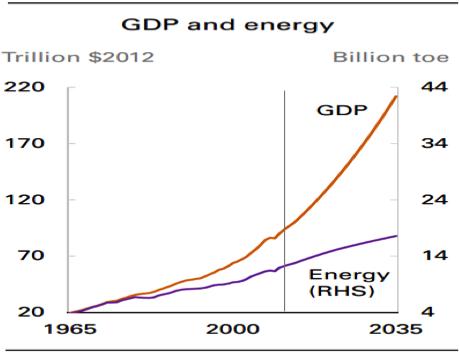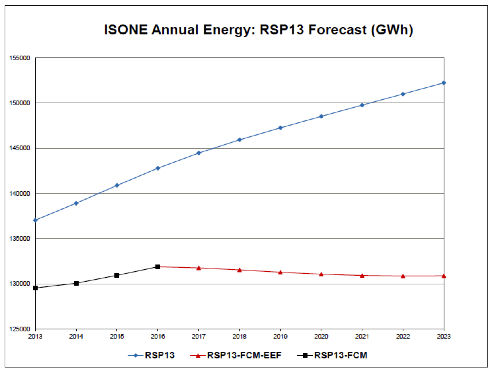By Josh Craft | Mon, February 17, 14
Here’s our brief rundown on key developments in energy efficiency policy from around the Northeast and Mid-Atlantic states NEEP is keeping tabs on.
Data Moment: Electricity Use Decoupling from Economic Growth, BP Finds
 Source: BP, Annual Energy Outlook for 2035, p. 16
Last month, Brad Plumer of the Washington Post reported that BP found in its Annual Energy Outlook for 2035 that energy consumption is gradually decoupling from economic growth. The graph below is yet more evidence that we are making significantly progress, through policy and through markets, to become more energy efficient.
New England Governors’ Statement on Energy Infrastructure
The New England Governors released a statement in December calling for the states to work together on a regional energy infrastructure investment initiative that “diversifies our energy supply portfolio while ensuring that the benefits and costs of transmission and pipeline investments are shared appropriately among the New England states.” While the governor’s statement was widely seen as expressing their intent to expand gas pipeline capacity and create new electric transmission to bring hydropower from Canada into the region (for which the New England States Committee on Electricity (NESCOE) has petitioned ISO-New England’s assistance), they also re-iterated their support for energy efficiency as a key resource to be included in load forecasting and transmission planning. The recent electricity price spikes in our region demonstrate the importance of our natural gas energy efficiency programs to ensuring reasonably-priced electricity.
ISO-New England & Energy Efficiency
Source: BP, Annual Energy Outlook for 2035, p. 16
Last month, Brad Plumer of the Washington Post reported that BP found in its Annual Energy Outlook for 2035 that energy consumption is gradually decoupling from economic growth. The graph below is yet more evidence that we are making significantly progress, through policy and through markets, to become more energy efficient.
New England Governors’ Statement on Energy Infrastructure
The New England Governors released a statement in December calling for the states to work together on a regional energy infrastructure investment initiative that “diversifies our energy supply portfolio while ensuring that the benefits and costs of transmission and pipeline investments are shared appropriately among the New England states.” While the governor’s statement was widely seen as expressing their intent to expand gas pipeline capacity and create new electric transmission to bring hydropower from Canada into the region (for which the New England States Committee on Electricity (NESCOE) has petitioned ISO-New England’s assistance), they also re-iterated their support for energy efficiency as a key resource to be included in load forecasting and transmission planning. The recent electricity price spikes in our region demonstrate the importance of our natural gas energy efficiency programs to ensuring reasonably-priced electricity.
ISO-New England & Energy Efficiency
 Source: ISO-New England, 2013 Regional System Plan
Oil Heat Energy Efficiency
The U.S. Congress recently passed the Farm Bill, and along with it, it re-authorized the Oilheat Efficiency, Renewable Fuel and Jobs Training Act, informally known as the National Oilheat Research Alliance (NORA). NORA allows oilheat retailers to pay a small assessment on heating oil sales in twenty-three states to support programs that benefit oilheat customers. Fifteen (15) percent of these funds will go towards energy efficiency measures and oilheat system replacements, which will allow some oilheat dealers to provide energy efficiency services to their customers. While the impact of such federal action will be impactful, NEEP continues to work with our allies in supporting state oilheat efficiency legislation, such as H. 2741 in Massachusetts that would allow for much greater investments in energy efficiency resources for homes and businesses that rely on oilheat.
State Energy Efficiency Proceedings
Source: ISO-New England, 2013 Regional System Plan
Oil Heat Energy Efficiency
The U.S. Congress recently passed the Farm Bill, and along with it, it re-authorized the Oilheat Efficiency, Renewable Fuel and Jobs Training Act, informally known as the National Oilheat Research Alliance (NORA). NORA allows oilheat retailers to pay a small assessment on heating oil sales in twenty-three states to support programs that benefit oilheat customers. Fifteen (15) percent of these funds will go towards energy efficiency measures and oilheat system replacements, which will allow some oilheat dealers to provide energy efficiency services to their customers. While the impact of such federal action will be impactful, NEEP continues to work with our allies in supporting state oilheat efficiency legislation, such as H. 2741 in Massachusetts that would allow for much greater investments in energy efficiency resources for homes and businesses that rely on oilheat.
State Energy Efficiency Proceedings
- ISO-New England is undertaking two initiatives that have significant implications for energy efficiency resources in the Northeast region. First, it has release a preliminary draft of its 2017-2023 Energy Efficiency Forecast. The forecast, which predicts energy and capacity savings based on state energy efficiency budgets, shows that energy efficiency resources will reduce annual electricity consumption by about 1,550 GWh and peak demand by 210 MW per year. The result according to ISO: “Generally, energy remains flat in the region with notable reductions in energy in VT and RI.” ISO welcomes comments on the draft through March 3 at eeforecast@iso-ne.com.
- ISO-New England has also filed a proposal with the Federal Energy Regulatory Commission (FERC) to alter the Forward Capacity Market (FCM) by creating a “Pay-for-Performance” mechanism. Under the new rules, ISO-NE would require participating resources to perform during shortage events; non-performers would be penalized, while performing resources would be rewarded. A number of stakeholders have expressed concerns with the proposal, in part because it creates uncertainty about whether energy efficiency resources will be able to continue to participate in the FCM under the new rules. Energy efficiency resources are passive by their nature and cannot be dispatched in real-time. For more background as well as an alternative proposal from the Northeast Power Pool (NEPOOL), see ISO’s blog here. A final ruling is expected by FERC by May 14, 2014.
- New York Energy Efficiency Portfolio Standard (EEPS) Restructuring Proposal: New York Public Service Commission (PSC) issued a significant order in December approving many changes to the Energy Efficiency Portfolio Standard (EEPS) that were outlined in a proposal by Department of Public Service (DPS) staff this fall. Importantly, the PSC sets in a motion a process to create a new stakeholder advisory board that will replace the current advisory groups, require NYSERDA and the utilities to work together to benchmark their energy efficiency programs and reduce duplication, and revise cost-effectiveness screening methods to move away from requiring programs to screen at the measure level.
- EmPOWER Maryland 2015-2017 Programs: Maryland stakeholders, led by the Maryland Energy Administration, continue to move forward to renew and continue their energy efficiency programs beyond 2014, when the current program year ends. The EmPOWER Working Group is seeking to alter its avoided cost methodology, how it screens programs for cost-effectiveness, and create a potential study to set savings targets for future years. NEEP has recently worked with MEA and other advocacy groups to provide comment to the Cost-Effectiveness working group and our comments can be seen here.
- Vermont Demand Resources Plan: The Vermont Public Service Board has begun to consider savings targets and budgets for its 2015-2017 electric energy efficiency utilities as part of the latest Demand Resources Plan proceeding (EEU 2013-01). Among the various scenarios being considered is an aggressive savings level of 3 percent of electric sales by 2019 proposed by VEIC. Comments on the various scenarios are due to the Public Service Board by March 12, with a final decision expected on budgets and savings targets expected in May.
